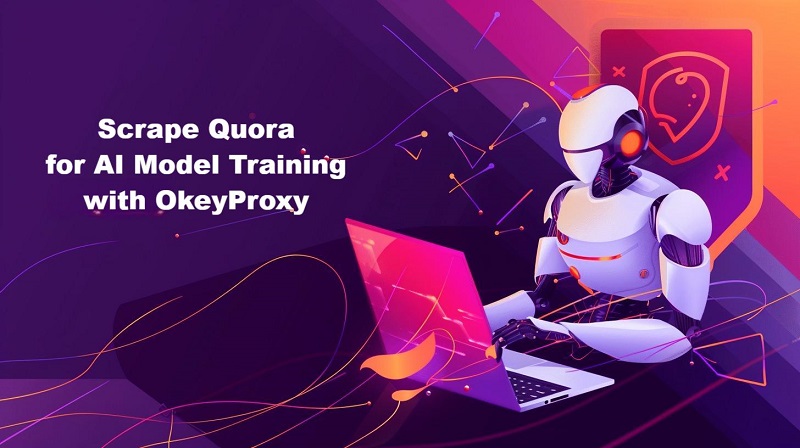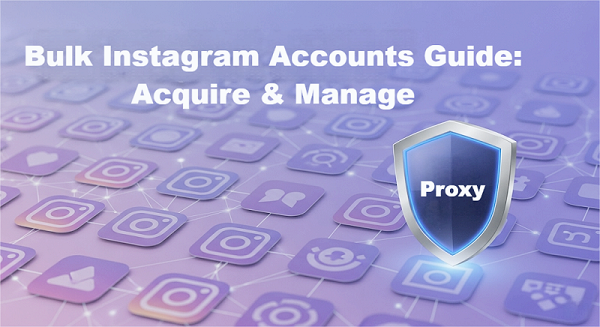Scrape Quora for AI Model Training with OkeyProxy
At its core, Quora is a platform where real people ask real questions and receive a variety of thoughtful, informed answers. This dynamic creates a natural conversational flow that is difficult to replicate with synthetic or overly curated datasets. For AI developers and machine learning researchers, these conversations provide an exceptional source of training data, particularly for models focused on natural language processing (NLP), semantic understanding, and conversational AI.
Quora’s data can fuel smarter and context-aware solutions.
Despite its immense value, Quora does not provide an official, comprehensive public API for full data access. While limited data may be accessible via third-party tools or platform partnerships, scraping remains the most viable route for independent researchers, startups, and smaller AI labs to gain access to this content at scale. This makes web scraping not only a technical solution but a strategic necessity for those looking to build advanced NLP systems or gain actionable intelligence.
In this tutorial, we’ll guide you through scraping Quora data responsibly, integrating proxies for seamless access, and leveraging it for AI model training. Let's get started.
What is Quora?

Quora is a global Q&A platform where users ask, answer, and discuss topics ranging from niche technical queries to broad societal trends. With over 300 million monthly active users, it’s a hub of authentic, user-generated content, making it a valuable resource for extracting structured and unstructured data.
What Data Can You Scrape from Quora?
Quora offers a variety of data points that can be scraped for AI training or analysis:
● Questions: Topics and queries reflecting user interests.
● Answers: Detailed, often expert-written responses with rich context.
● User Profiles: Insights into expertise levels and demographics (public data only).
● Engagement Metrics: Upvotes, shares, and comments to gauge content popularity.
● Metadata: Post dates, categories, and tags for trend analysis.
Why Quora’s Data Matters
1. Authenticity and Diversity
Quora content is written by real users ranging from curious laypeople to subject-matter experts. This makes it richer and more diverse than many other sources of textual data. The wide range of perspectives, personal experiences, and expertise levels make it an ideal training ground for AI systems that must handle the unpredictability of real-world input.
2. Rich Contextual Structure
● Each post on Quora typically includes: A question with a natural language structure.
● Multiple answers, offering a variety of styles, tones, and reasoning.
● Metadata like topics, upvotes, user bios, and answer timestamps.
This context is incredibly useful for supervised machine learning tasks and semantic analysis, enabling more sophisticated applications than plain text sources.
3. Topic Breadth and Depth
From niche tech discussions to life advice and philosophical debates, Quora’s topic range is expansive. This allows models to learn topic-specific language, cultural references, and even slang, something that pre-packaged datasets rarely offer.
What You Can Do With Quora Data
Here’s what you can build or analyze with Quora's data:
| Use Case | Description |
| Train NLP Models | Improve question-answering systems, text summarizers, and dialog agents. |
| Sentiment Analysis | Analyze emotional tone across different answers or topics. |
| Topic Modeling | Identify and categorize emerging themes or questions by clustering data. |
| Market Research | Discover consumer pain points and trends in user questions. |
| Competitor Analysis | Uncover mentions and opinions about specific brands or products. |
| Content Recommendation | Train recommendation engines for educational or knowledge platforms. |
| Chatbot Training | Use Q&A pairs as training data for conversational AI models. |
Editor's Tip: Quora’s data structure (question + multiple answers) is ideal for creating high-quality, labeled datasets without extensive manual tagging.
Who Can Benefit from Scraping Quora?
AI & Machine Learning Engineers
Quora’s rich linguistic and structural variety enables better training for language models, question-answering systems, and semantic search engines.
Businesses & Product Teams
From product-market fit assessments to consumer sentiment tracking, Quora gives businesses insight into real customer needs, struggles, and opinions, often before they hit mainstream media.
Data Analysts & Researchers
Academics and industry analysts use Quora to study behavioral patterns, public opinion, and online discourse on current events and social issues.
Conversational AI Developers
Chatbot and virtual assistant builders use Quora data to train systems that respond naturally and accurately to user questions.
Educators & Learning Platforms
Quora’s discussions help content teams understand learning gaps and commonly misunderstood concepts, improving how they deliver educational material.

Unique Insight: The Human Element in AI Training
Most public datasets for AI are static and overly curated. Quora, on the other hand, reflects real-time human expression, complete with ambiguity, contradiction, and creativity. These are exactly the features that push AI systems toward greater nuance and generalization.
By incorporating Quora data, you’re not just teaching machines to understand text, but you’re also teaching them to understand people.
Step-by-Step Tutorial: How To Scrape Quora with OkeyProxy
Here’s a detailed guide to scraping Quora data using Python, with OkeyProxy integration to avoid blocks and ensure scalability.
Step 1: Set Up Your Environment
Before scraping, set up your Python environment with the necessary tools.
● Install required libraries:
bash
pip install requests beautifulsoup4 pandas
● Ensure you have Python 3.8+ installed.
● Sign up for an OkeyProxy account to get your API key and proxy credentials (more on OkeyProxy below).
Tip: Use a virtual environment to keep dependencies organized:
bash
python -m venv quora_scraper
source quora_scraper/bin/activate # MacOS/Linux
quora_scraper\Scripts\activate # Windows
Step 2: Understand Quora’s Structure
Quora’s pages are dynamic, with content loaded via JavaScript.
Key elements to scrape include:
● Question Titles: Found in <span class="q-box qu-userSelect--text">.
● Answers: Located within <div class="puppeteer_test_answer_content">.
● Engagement Metrics: Upvotes and comments in specific <span> tags.
Note: Inspect Quora’s HTML using browser developer tools to identify the latest class names, as they may change.
Step 3: Write the Scraper Code
Here’s a Python script to scrape questions and answers from a Quora topic page.
python
import requests
from bs4 import BeautifulSoup
import pandas as pd
# Define the target URL
url = "https://www.quora.com/topic/Artificial-Intelligence"
# Set up OkeyProxy credentials
proxy = {
"http": "http://your_username:[email protected]:1234",
"https": "http://your_username:[email protected]:1234"
}
# Send request with proxy
response = requests.get(url, proxies=proxy)
soup = BeautifulSoup(response.text, "lxml")
# Extract questions
questions = soup.find_all("span", class_="q-box qu-userSelect--text")
question_list = [q.get_text().strip() for q in questions]
# Extract answers (simplified for demo)
answers = soup.find_all("div", class_="puppeteer_test_answer_content")
answer_list = [a.get_text().strip() for a in answers]
# Save to DataFrame
data = {"Question": question_list, "Answer": answer_list[:len(question_list)]}
df = pd.DataFrame(data)
df.to_csv("quora_data.csv", index=False)
print("Scraped data saved to quora_data.csv")
Step 4: Integrate OkeyProxy for Reliable Scraping
Quora employs anti-bot measures like CAPTCHAs and IP bans. OkeyProxy provides a robust solution to bypass these restrictions.
What is OkeyProxy?
OkeyProxy is a premium proxy service offering residential and datacenter proxies to ensure anonymous, high-speed web scraping. With a global IP pool and easy-to-use dashboard, it’s ideal for scaling data collection without blocks.
● Key Features: Millions of residential IPs across 150+ countries.
○ Automatic IP rotation to avoid detection.
○ High success rates for scraping dynamic websites like Quora.
● Why Use OkeyProxy? Ensures uninterrupted scraping, supports geo-targeting, and simplifies integration with tools like Python’s requests.
Get started with OkeyProxy’s flexible proxy plans now.
Proxy Integration Code: Replace your_username and your_password in the script above with your OkeyProxy credentials. For advanced users, OkeyProxy supports SOCKS5 and HTTP proxies for additional flexibility.
Step 5: Handle Dynamic Content (Optional)
For JavaScript-heavy pages, use Selenium for browser automation:
● Install Selenium: pip install selenium
● Download a WebDriver (e.g., ChromeDriver).
● Modify the script:
python
from selenium import webdriver
from bs4 import BeautifulSoup
import pandas as pd
# Set up Selenium with OkeyProxy
options = webdriver.ChromeOptions()
options.add_argument('--proxy-server=http://your_username:[email protected]:1234')
driver = webdriver.Chrome(options=options)
# Navigate to Quora
url = "https://www.quora.com/topic/Artificial-Intelligence"
driver.get(url)
# Parse page source
soup = BeautifulSoup(driver.page_source, "lxml")
questions = soup.find_all("span", class_="q-box qu-userSelect--text")
question_list = [q.get_text().strip() for q in questions]
# Save to CSV
df = pd.DataFrame({"Question": question_list})
df.to_csv("quora_selenium_data.csv", index=False)
driver.quit()
print("Scraped data saved to quora_selenium_data.csv")
Step 6: Clean and Prepare Data for AI Training
● Remove Duplicates: Use df.drop_duplicates() to clean redundant entries.
● Format for AI: Convert to JSON for LLM training:
python
df.to_json("quora_data.json", orient="records")
● Validate Data: Ensure text is free of HTML artifacts using regex or libraries like clean-text.
Key Takeaway: Clean, structured data is critical for effective AI model training.
Step 7: Test and Scale
● Testing on a small dataset (e.g., a single Quora topic page) helps verify that your scraper extracts the correct data and handles Quora’s dynamic structure without errors. To verify output:
○ Check the generated quora_data.csv file to ensure questions and answers are correctly extracted.
○ Look for issues like missing data, HTML artifacts, or mismatched question-answer pairs.
○ Validate data quality (e.g., no empty fields, proper text encoding).
● Scale by iterating over multiple URLs or topics using a loop.
● Monitor proxy usage via OkeyProxy’s dashboard to optimize costs.

Technical Deep Dive: Key Terms Explained
● Web Scraping: Automated extraction of data from websites using tools like requests or Selenium.
● Proxies: Intermediary servers that mask your IP to prevent blocks. OkeyProxy’s residential proxies mimic real users for higher success rates.
● BeautifulSoup: A Python library for parsing HTML and extracting structured data.
● Selenium: A tool for automating browsers, ideal for scraping JavaScript-rendered content.
● IP Rotation: Automatically switching IP addresses to avoid detection, a feature OkeyProxy handles seamlessly.
Comparison: Manual vs. Proxy-Enabled
| Approach | Pros | Cons | Ideal Use Case |
| Manual Scraping | Free, no external tools needed, good for small-scale projects | Time-consuming, prone to blocks, limited scalability | One-off research or small datasets |
| Proxy-Enabled | Bypasses anti-bot measures, scalable, reliable with services like OkeyProxy | Requires proxy setup, potential costs | Large-scale scraping, dynamic websites |
Tip: For Quora, proxy-enabled scraping with OkeyProxy strikes a balance between control and reliability.
Conclusion
Scraping Quora for AI model training opens up a world of possibilities, from enhancing chatbots to uncovering market insights. With OkeyProxy’s reliable proxies, you can bypass anti-bot measures, scale your scraping efforts, and collect high-quality data effortlessly. Follow the steps outlined, prioritize ethical practices, and leverage Quora’s vast knowledge base to supercharge your AI projects. Ready to start? Visit OkeyProxy Socks5 Rotating Residential Proxies Provider to explore their proxy solutions and take your scraping to the next level.
FAQs
1. What are common technical challenges when scraping Quora?
Quora’s dynamic content and anti-bot measures (CAPTCHAs, IP bans) can block scrapers. Use Selenium for JavaScript rendering and OkeyProxy’s rotating proxies to bypass restrictions.
2. Do I configure OkeyProxy for scraping?
Sign up at OkeyProxy.com, retrieve your username and password, and add them to your script’s proxy settings (e.g., http://username:[email protected]:1234). Test with a single request to ensure connectivity.
3. Why use proxies for Quora scraping?
Proxies prevent IP bans by rotating addresses, ensuring uninterrupted data collection. OkeyProxy’s residential IPs mimic real users, reducing detection risks.
4. What are ideal use cases for Quora data in AI?
Quora data excels in training NLP models (e.g., chatbots), sentiment analysis, and market research. It provides diverse, human-written text for context-aware AI applications.
5. How do I troubleshoot scraping errors?
Check for HTTP errors (e.g., 403 Forbidden) to ensure proxies are correctly configured. Verify HTML class names, as Quora’s structure may change. Use OkeyProxy’s dashboard to monitor IP performance.























